Summer Management in Layer
Dr. Rita Bharti (reeta5072@gmail.com), PhD scholar, ICAR-IVRI, Bareilly, UP
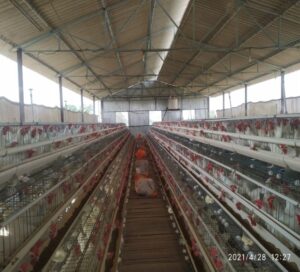
Fig. 1- Open house system
Abstract
In summer, as the temperature rises poultry suffer from heat stress. It is a condition of imbalance between heat generation and heat loss from the body. Heat stress has deteriorate effect on health, egg production and egg quality also. Although heat stress effects depend on genetics of breed, body weight, level of egg production, level of feed intake, feed quality, and over-crowding of birds in cage or house. When high environmental temperature coupled with high humidity is more vulnerable for poultry. Whenever, birds are exposed to prolong heat stress their body immunity hamper and chance of secondary pathogenic infection highly increased that, may cause high mortality, heavy production loss and deterioration in egg quality. Layer birds adopt different activities to relieving from heat stress i.e. reduce their activity, try to move away from each other, reduce feed intake, increase water consumption, open their wings to half extended to provide more surface area for cooling, open mouth breathing with frequent respiration to reduce body heat by evaporative cooling i.e. panting, try to keep cool by dipping their comb and wattles in water. When the environmental temperature rises above ambient temperature there is need to take more caution to manage the flock. For maximizing production different practices may be adopted by poultry farmers like housing, feeding, water management, medication and light management.
Keywords-: Heat stress, heat stress symptoms, management, Heat stress effects, Panting, Layer birds
https://www.pashudhanpraharee.com/summer-management-of-poultry-birds-layer-broilers-3/
In India poultry has shifted from unorganized sector to organized scientific poultry farming. Commercially, most of the layer birds are reared in conventional cages in open house system. The housing system is essential for survival of birds from adverse climatic effects. Extreme climate condition has unpropitious effect on livestock as well as on poultry. Poultry are more susceptible to high ambient temperature during summer in comparison to other livestock because birds don’t have sweat glands like mammals. Thermo-neutral zone for poultry varies between 220C – 260C. However, birds try to regulate their body temperature by losing heat from body. Birds dissipate their body heat to maintain thermo-neutral temperature by four different mechanisms i.e., 1. Convection mean body heat lost direct in surrounding air. Poultry may increase exposed surface area by drooping and spreading wings. 2. Radiation mean transfer of body heat to a distant cooler objects (i.e. walls, ceiling, equipment). 3. Evaporative Cooling mean rapid, shallow, open-mouth breathing for increases heat loss direct from mouth and respiratory tract i.e. panting. During panting bird lost approximately, 540 calories energy per gram of water by the lung. 4. Conduction means body heat loss with direct contact to cooler objects. In summer, environmental temperature varies from 300C to 450 C in most of the areas in tropical country like India. As the temperature raise above the ambient temperature layer feel discomfort and highly effect on egg production although heat generation depend on genetic of breed, body weight, level of egg production, level of feed intake, feed quality, and over-crowding of birds in cage or house. Poultry feel dis-comfort whenever, heat generation is higher than the heat loss. When high environmental temperature coupled with high humidity is highly vulnerable for poultry health, production and egg quality also. Heat stress is a condition of imbalance between heat generation and heat loss from the body. For maintaining the internal environment of shed, different practices can be adopted by poultry farmers like housing, feeding, water management, medication and light management. There is highly essential to manage poultry in summer so that heat stress can avoid.
Effects of heat stress in layer:
Heat stress have direct effect on feed intake, growth rate, body weight, reproductive performance and egg production & egg quality in layer birds. Feed intake will reduce by 1.2% for each one-degree centigrade rise in the temperature from 220C – 320C and 5% for each one-degree centigrade rise in the temperature range of 320C – 380C. Water intake will increase by 7% for every degree rise in temperature above than 210C.
Whenever, birds are exposed to prolong heat stress their body immunity became down than chance of secondary pathogenic infection highly increased which, may cause high mortality, heavy production loss and deterioration in egg quality. Layer are adopted different ways to relieving from heat stress i.e. reduce heat generating activity, try to move away from each other, reduce their feed intake, increase water intake, open their wings to half extended to provide more surface area for cooling, open mouth breathing with frequent respiration to reduce body heat by evaporative cooling i.e. panting, try to keep cool by dipping their comb and wattles in water. When the environmental temperature rises above ambient temperature there is need to take more cause to manage the flock.
Summer management in layer
- Housing management
- Water management
- Feeding management
- Light management
- Medications
- Some other practices
- Housing management
Roof management
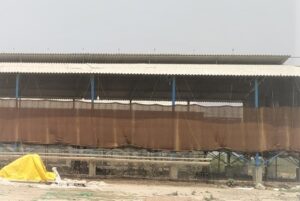
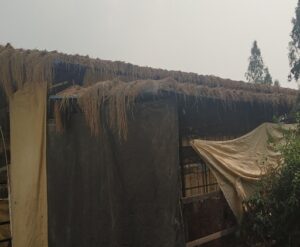
Fig. 2 – Poultry house roof and thatching material
- White wash on roof tops.
- Roof top cover with agro-waste or thatched material.
- Arrange sprinklers on roof.
- Provide 4-6 feed roof over hanged to protect from direct sunlight.
- Provide ridge ventilation to removal of hot air.
Shed management
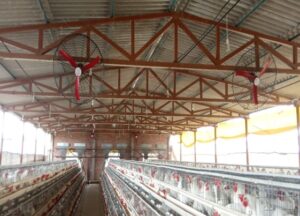
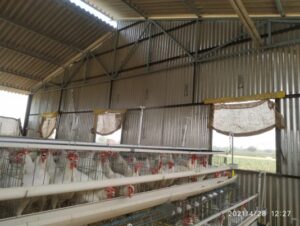
Fig.3- Fans and Foggers
- Installation of fogger for the reducing the temperature inside the shed.
- Installation of 36 inch 1/2 hp horizontal fans in every 500-600 sq ft at 60 degree angle to increase air circulation inside shed.
- Foggers and fans should be collectively operated according to the humidity inside shed. Only fan should be used when humidity is high. If possible fogger should be used with timers in 1:3 ratio. We can also on fogger for 2 minutes in every 10 minutes manually.
- Clean all spider webs and dust from wire net to increase air flow.
- Install jute curtains in both side of shed longitudinally with pipeline by which wetting of curtains to protect birds from direct hot air.
- Maintain litter in good condition and remove cake frequently to prevent the moisture and ammonia build-up in deep litter system.
Reduce over stocking of birds in cages and provide more floor space in deep litter also.
Water management
Water management is the most critical parameter because feed consumption depending on water consumption. In summer when temperature reaches above 30 degree centigrade, water consumption becomes 3-4 times more than normal. So its utmost requirement to provide plenty cool and clean water during summer.
- Use nipple drinkers to provide clean water
- Flushing of water tank and pipe line 2-3 times in a day during peak summer to provide cool water.
- Cover-up the water sources and pipe line with gunny bag or other materials to protect from direct sunlight.
- If possible then keep the water tank inside the shed to ovoid direct exposer from sunlight.
- In cage system with water pipeline install water channel to provide plenty of water during summer.
- Provide extra drinkers in deep litter.
- Ensure water testing time to time to provide clean and good quality water.
- Ensure cleaning of pipeline on regular basis for removal of biofilm.
Use ice cubes in water tank to provide always cool water in summer
.Feeding management
Feeding management can be divided in three parts-
- Feed form
- Feed nutrition
- Feeding time
Feed form
- Provide crumb feed (1.5 to 2mm size) in summer because in consumption of crumb feed less energy expend as compare to mash feed.
- In layer chicks brooding broiler starter can be provided for first 10 days to overcome the bodyweight loss in summer.
- Pellet feed is helpful in summer as compare to mash feed.
Feed nutrition
- High energy diet should be given in summer because birds have more energy losses during panting.
- Energy in feed should be supplemented with oil rather than grain because fat has lowest heat increment value in comparison with carbohydrate and protein.
- Feed consumption is reduced in summer, to overcome nutritional and productive losses we should supplemented with 20-30 percent more amino acids, vitamins and minerals rather than increasing direct protein level.
- Increase calcium and phosphorus level in feed to overcome thin shell eggs more often coming in summer due to respiratory alkalosis ( More co2 losses during panting in summer).
Feeding time
- Feed should be provided in cooler part of the day i.e. early morning and late evening.
- 70-80 percent feed should be provided in early morning and remaining part in late evening.
- Feed stirring should be avoided in hottest part of the day i.e. after 12 pm to 6 pm.
- Ensure withdraw of feed before 3-4 hours of anticipated hottest period of the day to reducing heat stroke mortality due to body heat generated after digestion of feed.
- Increasing feeding frequency may help to combat heat stress effect due to feed consumption.
Lighting management
- Normally, we provide 16 hours day length in layers for optimum productivity of birds.
- Birds reduce feed consumption in summer specially, during hottest part of the day so we have to adjust light timing by which birds get more cooling hours for feeding.
- In summer we should provide early morning light 4 am to late evening 8 pm.
- Midnight lighting of 1-2 hours may help to overcome reduced feed consumption in summer by which we will be able to maintain target bodyweight for achieving better performances.
Medication
- Use Sodium bicarbonate in feed @1-2 kg / tonne feed in summer because more carbonate ions loss during panting as carbon dioxide results in reduce eggshell quality as shell made up of calcium carbonate. NaHCO3 (Meetha soda) help to improve egg shell quality.
- Use electrolytes in feed for maintaining acid –base balance.
- Potassium chloride (KCl), Ammonium chloride (NH4Cl) through feed may also help to restore losses of ions.
- Anti-stress vitamins like Vitamin C @ 150 mg /kg help in heat stress.
- Antioxidant Vitamin E @ 125 mg/kg.
- We can use Chromium supplementing products may help in heat stress.
- Aspirin powder @ 0.3 gm /lit water.
F) Some other practices
- Plantation without branches plants or greenery around the shed helps in controlling shed temperature in thermo-neutral zone.
- We should not disturb birds during hottest part of the day.
- Other activities like vaccination, Handling, Shifting, de-beaking, should be carried out in cooler part of the day.
Reference
Hy-Line International Management Guide: Understanding Heat Stress in Layers: Management Tips to Improve Hot Weather Flock Performance. www.hyline.com
Heat stress in poultry solving the problem – Gov.uk. www.defra.gov.uk
www.Biomin.net


